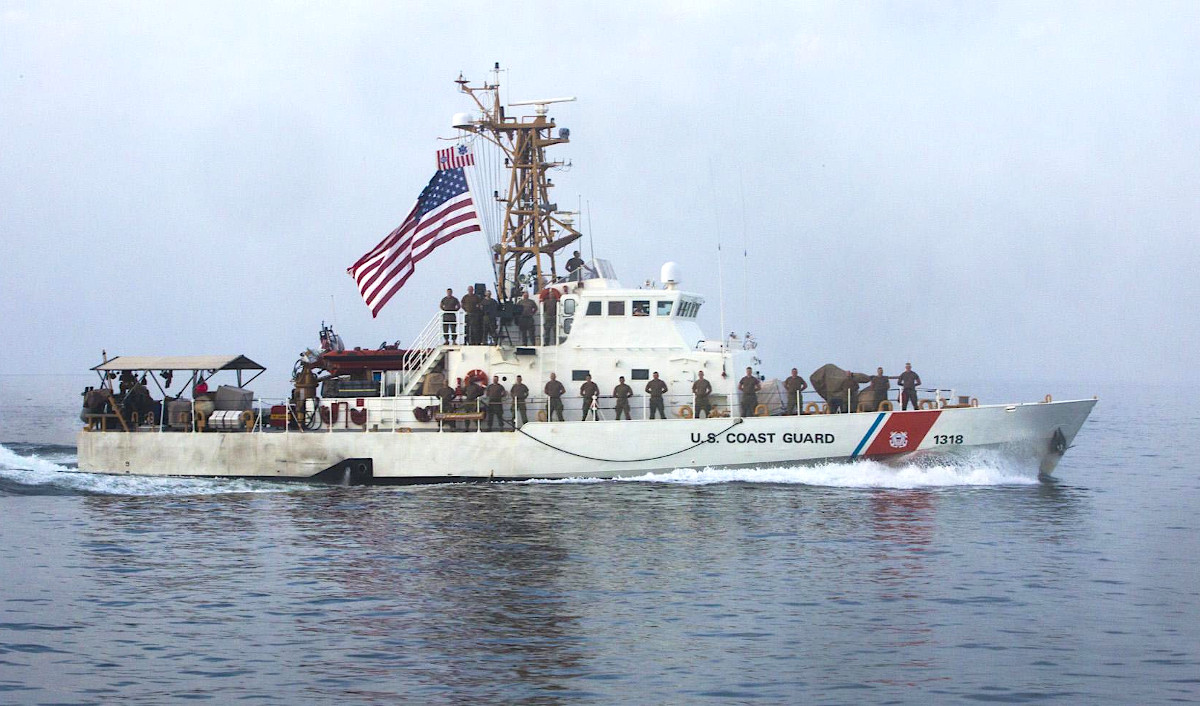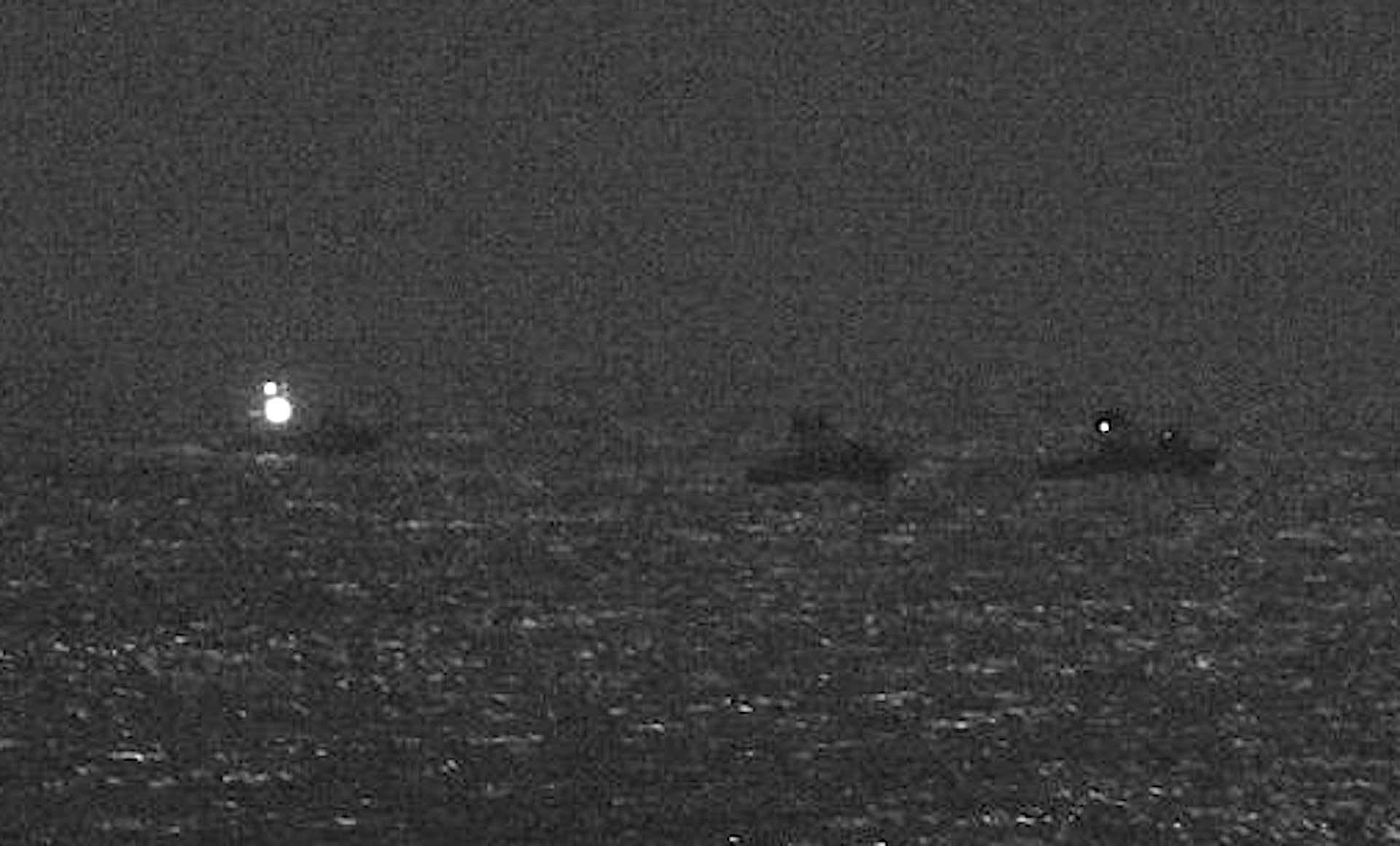The U.S. Navy says that its Cyclone class patrol craft USS Firebolt fired warning shots toward a group of three small Iranian boats during an altercation yesterday in the Persian Gulf. This disclosure comes less than a day after the service confirmed that another group of boats belonging to Iran’s Islamic Revolutionary Guard Corps, including a unique catamaran, had harassed U.S. Coast Guard cutters in that same body of water.
Firebolt was sailing together with the U.S. Coast Guard’s Island class patrol boat USCGC Baranoff
during the incident, which started at around 8:00 PM local time on April 26. The Navy did not identify the types of small Iranian boats that harassed the American ships, but the Islamic Revolutionary Guard Corps (IRGC) is known to operate a diverse fleet of small craft in this general category.

The Iranian boats “failed to exercise due regard for the safety of other vessels as required under international law as they came into close proximity to U.S. naval vessels in international waters,” the Navy said in a statement. “The IRGCN [Islamic Revolutionary Guard Corps Navy] armed speed boats rapidly approached U.S. Navy patrol coastal ship USS Firebolt (PC 10) and U.S. Coast Guard patrol boat USCGC Baranoff (WPB 1318) to an unnecessarily close range with unknown intent, including a closest point of approach (CPA) of 68 yards to both U.S. ships.”
“The U.S. crews issued multiple warnings via bridge-to-bridge radio and loud-hailer devices, but the IRGCN vessels continued their close range maneuvers,” the press release continued. “The crew of Firebolt then fired warning shots, and the IRGCN vessels moved away to a safe distance from the U.S. vessels.”

The Navy did not say what weapon or weapons the Firebolt had used to warn off the Iranian boats. The primary gun armament of each Cyclone class patrol craft is a pair of 25mm automatic cannons, mounted one each at the bow and toward the stern. They also have various smaller machine guns and automatic grenade launchers on mounts around the boat, as well as a launcher for AGM-176 Griffin precision-guided missiles.
The video below highlights the different weapons onboard the Cyclone class patrol craft.

“Throughout the interaction, U.S. forces proactively communicated with the IRGCN vessels and executed pre-planned responses to reduce the risk of miscalculation, avoid a collision, and to de-escalate the situation,” the Navy added. “U.S. naval forces continue to remain vigilant and are trained to act in a professional manner, while our commanding officers retain the inherent right to act in self-defense.”
“The IRGCN’s actions increased the risk of miscalculation and/or collision, were not in accordance with the internationally recognized Convention on the International Regulations for Preventing Collisions at Sea (COLREGS) “rules of the road” or internationally recognized maritime customs,” the Navy stressed. “In addition, the IRGCN actions were not in accordance with the obligation under international law to act with due regard for the safety of other vessels in the area.”

The incident follows a similar encounter between a pair of the Coast Guard’s Island class patrol boats and a group of IRGCN boats, including the Harth 55 class catamaran Shahid Nazeri, on April 2. You can read more about that here. The Wall Street Journal first reported on that earlier incident yesterday and the Navy confirmed it today, but there had been no previous mention of this more recent and serious dustup.
It’s not clear when the last time Navy ships have fired in the direction of Iranian boats, even as a warning, in the Persian Gulf or anywhere else. The USS Thunderbolt, another Cyclone class patrol craft, did fire warning shots at boats belonging to the IRGCN during an incident in 2017.
There were no shots fired during an incident last year, in which a swarm of Iranian vessels harassed a group of Navy and Coast Guard vessels in the Persian Gulf, including USS Firebolt. After that, however, then-President Donald Trump declared that he had “instructed the United States Navy to shoot down and destroy any and all Iranian gunboats if they harass our ships at sea” in one of his signature Tweets. The President clarified later that day that the rules of engagement had not changed and that “We’re covered 100 percent.”
This incident certainly stands in marked contrast to an incident in January 2016, in which the crews of two Navy Riverine Command Boats (RCB) surrendered themselves to IRGC forces after drifting into Iranian territorial waters near Farsi Island. One of the RCBs had broken down as both boats conducted a routine transit through the area. That international incident came to a close 15 hours later when Iran released the 10 sailors. The U.S. government denied issuing a formal apology to Iran, but the incident was a major propaganda coup for the regime in Tehran and became a major point of criticism of President Barack Obama and his administration.

Iran has a long history of harassing American warships in the Persian Gulf, but this practice had largely evaporated by the middle of the Trump administration for reasons that remain unclear. Other forms of provocative Iranian behavior, from seizing commercial vessels to using drones for harassment, did continue in the region. There were also a string of outright attacks, linked back to Iran, on oil tankers in the Gulf of Oman.
In 2019, the United States and Iran notably came dangerously close to open conflict after the IRGC shot down a Navy RQ-4A Broad Area Maritime Surveillance Demonstrator (BAMS-D) drone over the Gulf of Oman. The U.S. government also accused Iran of directly carrying out an unprecedented combination of drone and missile strikes on targets in Saudi Arabia later that year. This all was, of course, followed by the U.S. military’s killing of Iranian General Qassem Soliemani, head of the IRGC’s Quds Force, its branch responsible for operations outside of the country, in Iraq in January 2020 and Iran’s retaliatory ballistic missiles strikes on basing hosting American troops in that country.
President Joe Biden’s administration is now attempting to negotiate, indirectly, with Iran about the U.S. government rejoining a controversial multi-national deal regarding Tehran’s nuclear ambitions. In this context, Iranian officials have been publicly calling for Biden to relax crippling Trump-era sanctions on their country. Biden has stressed his intent not to offer any sanctions relief as a precondition to getting back into the so-called Iran Deal, but there have been reports that there may be some flexibility in this position.
Elements of the IRGC could certainly be working to try to strengthen Iran’s negotiation position and there are also certainly spoilers in Iran who are keen to undermine any rapprochement between the two countries. With all that in mind, there also have been and remain questions about just how much control Iran’s leadership actually exercises over day-to-day IRGC operations.
“The activities we usually see from the IRGC Navy are not necessarily activities directed by the supreme leader from the Iranian state, rather irresponsible actions by local commanders on scene,” Marine Corps General Frank McKenzie, head of U.S. Central Command, said at an event hosted by the American Enterprise Institute (AEI) just today. “We are very careful so as not to get into a provocative cycle as a result of that. Luckily our guys are very good … and they’re able to de-escalate.”
Clearly, at least some elements of the IRGC would prefer to see the situation heat up.
Contact the author: joe@thedrive.com
